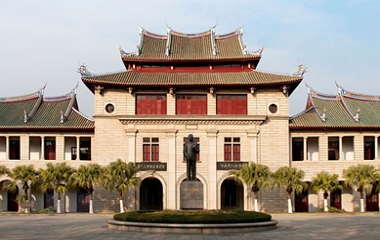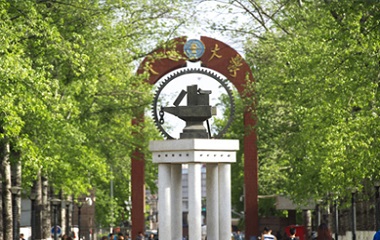[The Democratic Republic of the Congo] Karumb Noella Kavud, Hubei University of Technology
“Liao Bu Qi (Outstanding)!” I’d like to use these three Chinese characters to describe the enormous changes in China’s politics, economy, and culture over the past few decades. I’m a second-year international student at Hubei University of Technology studying civil engineering. I tend to pay close attention to the development of various buildings and infrastructure as a student of civil engineering. Every building’s structure and design have a message they aim to get across. As a result, every masterpiece of architecture conceals a beautiful story.
Many emerging nations are drawn to China’s path of growth. My home country, the Democratic Republic of Congo, is also currently in a development phase. There is a great deal of interaction with China, particularly in the infrastructure sector, and many Chinese businesses have begun undertaking projects in my country. The field of civil engineering encompasses all construction techniques.

To meet the needs of society as a whole, engineers use their expertise to build a range of social and public facilities while ensuring public safety and environmental sustainability. Hopefully, I’ll get the chance to help with building my country in the future.
In some ways, the tale of China’s development can be traced back to its incredible infrastructure accomplishments. The value of Chinese architecture goes beyond its use of materials, design, and adornment. The number of projects that represent the idea of “sustainability” is increasing. Many things that we once believed could only occur in the future are currently taking place all around us thanks to the “China speed.” Moving forward into the future does not necessarily mean abandoning tradition. We see in Chinese architecture a shift from tradition to modernity as well as a fusion of modernity and tradition.
All architectural components in ancient Chinese architecture are governed by social conventions, and it embodies conventional ideas of decorum and places an emphasis on ideas like ethics, form, scale, color, and structure. The concept of the “union of nature and man” has also had a significant impact on the evolution of traditional Chinese architecture. Traditional Chinese architecture is well-known for its vibrant ornamentation, magnificent roofs, soaring columns, and symbolic carvings of dragons and phoenixes. The concept of “union of nature and man,” or harmony with nature, had an influence on the development of this style.
After the 1840s, when China’s modern history began, Western influences started to show up in Chinese architecture. Between the 1840s and the 1920s, a new Chinese and Western-influenced style developed in China, and in the 20th century, some significant international architectural firms expressly incorporated Western architectural influences into modern China. Reform and opening up brought China into the world in the 1980s. The architecture of the Oriental landscape became more contemporary as cities rapidly modernized and industrial structures and skyscrapers began to develop. Modern building materials including concrete, lightweight bricks, steel, glass, and aluminum have become the standard.

China started to understand itself better as it became more integrated into the world. At this period, fresh architectural designs that combined traditional and modern features started to appear. The preservation and discovery of the value of traditional architecture began to receive renewed attention. Ancient Chinese architecture has an immense worth for Chinese culture. We are all quite familiar with the Forbidden City, Summer Palace, Yellow Crane Tower, and Yueyang Tower, each of which has a distinctive aesthetic and is ingrained in Chinese history as cultural landmarks.
The National Center for the Performing Arts and the Bird’s Nest (National Stadium) in Beijing have both established themselves as well-known national symbols of modern Chinese architecture, as have the Jinmao Tower and Oriental Pearl Tower in Shanghai. But I was drawn to something else. During my three years in China, I saw some incredible advancements in construction.
After the outbreak of the Covid pandemic in 2020, a hospital was constructed in Wuhan within 10 days. Architecture serves as both a monument and a place where people can live in.
“Wuhan, every day is different” is the city’s catchphrase. In this regard, I would like to assert the following based on my personal experience: “China of tomorrow won’t be the China of today.” I know deep down that there is an even better future waiting for us here. The pace of change in this country is incredible. More importantly, I am aware that this is not the power of one person or one administration, but the outcome of the efforts of every single Chinese person. The same people who have written a wonderful past will create an even greater future!

Regardless of the country we are in, the progress of architecture has given us a completely different living environment from dirt, clay, bamboo, rock and wood to concrete, steel, glass and fiber... In addition to advancing modernization, the building sector also generates employment. China has entered an era where modern civilization and traditional culture meet.
Today’s China is one of the most impressive countries in the world. She is still running on the road of continuous progress. I believe that with the speed of China, it is only a matter of time before we witness new achievements. Living in this country and experiencing all this has given me a clear idea of what I want to do in the future.
Simply put, a country’s development is not an individual’s achievement; rather, it is the result of everyone working together over an extended period of time. China of today motivates us. I now have a clearer picture of my future and that of my country after entering China, experiencing it, and knowing it. I believe that my country will also develop into a new world that is different every day!
The story is from "My Beautiful Encounter with China" Essay Competition organized by the Chinese Service Center for Scholarly Exchanges (CSCSE).










